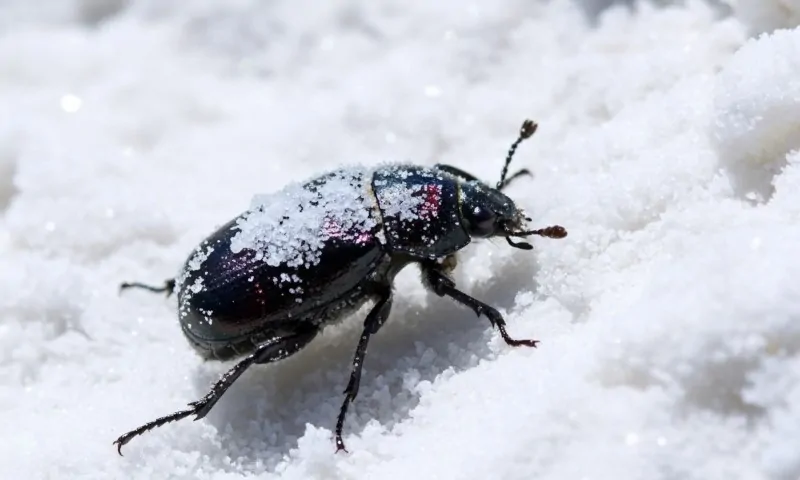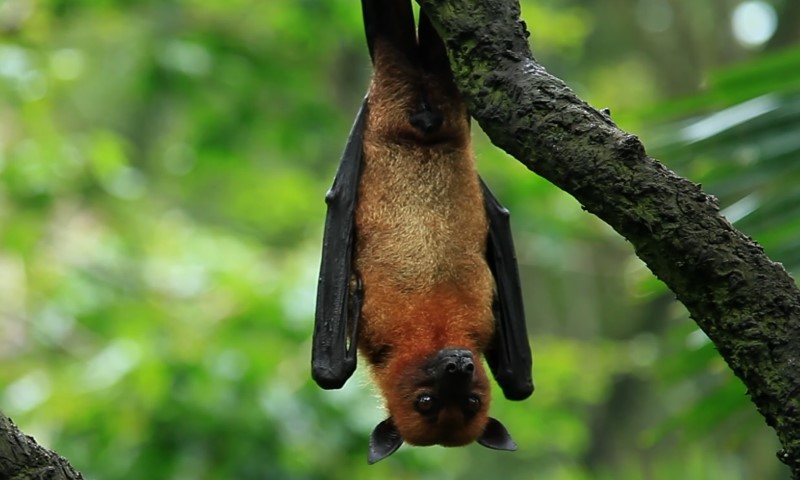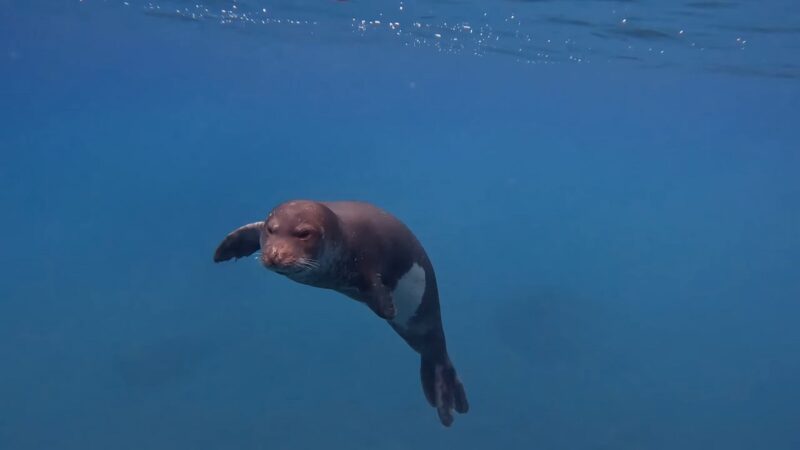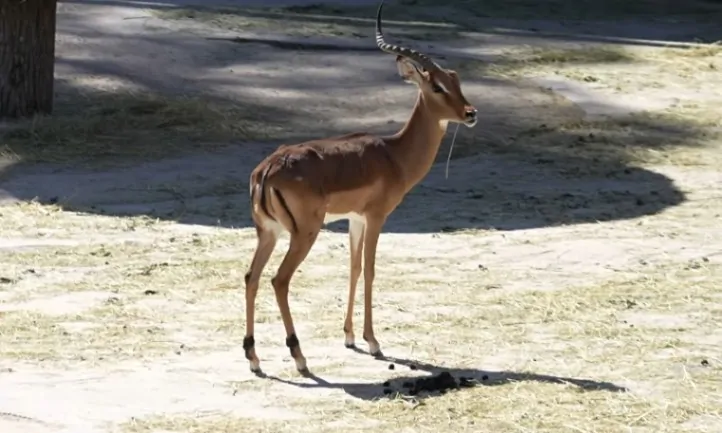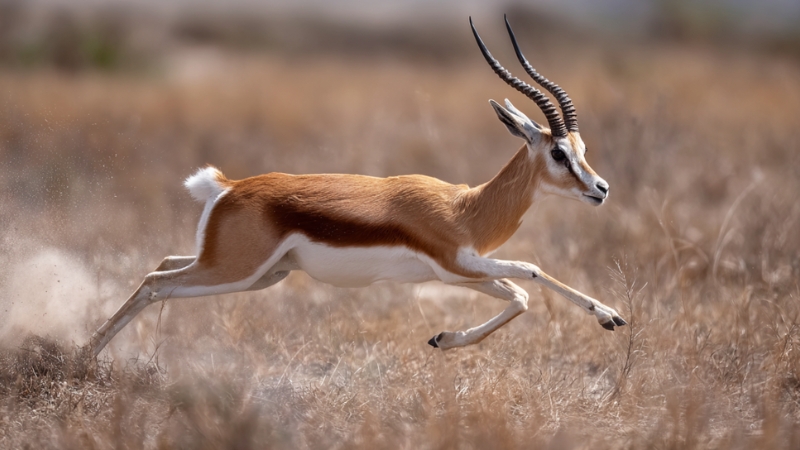When winter tightens its grip and temperatures plunge below zero, most animals retreat underground or perish. Freezing is usually fatal. Ice crystals puncture cell walls, block oxygen, and destroy the delicate machinery of life. Yet a few insects cheat death. They can freeze solid and later thaw in the sunlight, or avoid freezing altogether by turning their body fluids into natural antifreeze.
Biologists have spent decades studying these survivors, and the results are astonishing. Some species in Alaska, Canada, and even Antarctica can remain frozen for weeks, then resume life once the sun returns. The secret lies in two key strategies that shape how they endure the cold.
Table of Contents
ToggleKey Points
- Some insects freeze solid and survive, while others avoid freezing using antifreeze compounds.
- Species like Eurosta solidaginis , Upis ceramboides , and Belgica antarctica tolerate internal ice and revive when warmed.
- Others, like Cucujus clavipes and snow fleas, supercool body fluids to stay unfrozen even below −40 °C.
- Survival depends on antifreeze proteins, glycolipids, sugars, dehydration, and repair mechanisms that limit freeze damage.
Two Survival Blueprints
When temperatures drop below freezing, insects rely on two main survival tactics, unlike desert insects who can deploy multiple tactics at once. Some endure being frozen, while others prevent it entirely.
Freeze Tolerance
According to PubMed research , some insects allow ice to form inside their bodies in a controlled way. They don’t fight freezing; they manage it.
Their tissues produce compounds called cryoprotectants , mainly sugars and alcohols, that protect cells from damage and keep membranes flexible even in solid ice.
Examples include:
- Goldenrod gall fly larvae (Eurosta solidaginis)
- Alaskan beetle (Upis ceramboides)
- Antarctic midge (Belgica antarctica)
These insects endure freezing temperatures by turning their bodies into biochemical fortresses. Ice forms only in the spaces between cells, never inside.
When spring sun or a brief warm spell arrives, the ice melts, cells regain water balance, and life resumes.
Freeze Avoidance
Other species survive by never freezing in the first place. According to the Journal of Experimental Biology research , they supercool their body fluids, like bats, lowering their freezing point below zero without forming ice.
Through dehydration, removal of ice-nucleating particles, and special antifreeze proteins, they can stay liquid at astonishingly low temperatures.
A standout example is the Alaskan flat bark beetle (Cucujus clavipes) , whose larvae can reach temperatures of −35 to −42 °C without freezing. When the bark above them warms in the sun, they thaw and resume slow motion.
Some springtails, tiny jumping insects known as “snow fleas,” use the same strategy, staying active on bright winter days.
Both paths, tolerance and avoidance, share one goal: to prevent lethal ice inside cells. The chemistry behind it defines who can “reawaken in the sun” and who stays frozen forever.
The Snow Fleas on the White Stage
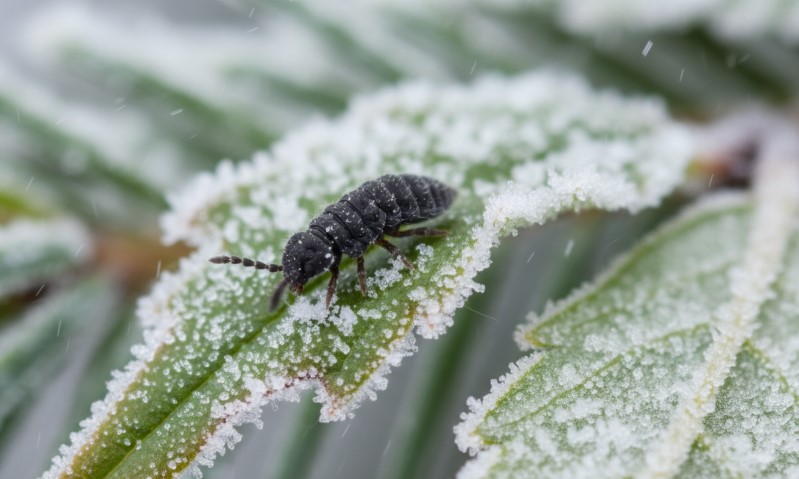
If you’ve ever seen black specks bouncing across late-winter snow, you’ve witnessed one of nature’s quiet miracles. Those specks are springtails : tiny six-legged arthropods, not true insects, yet close relatives.
The best-known is Hypogastrura harveyi , nicknamed the snow flea . When sunlight warms the snow surface to just a few degrees below zero, they come alive, hopping across the crust with spring-loaded tails called furcula .
How They Do It
Their secret weapon is a set of glycine-rich antifreeze proteins . These molecules bind to ice crystals and stop them from growing.
Structural studies show that they form flexible, ribbon-like helices that cover the ice surface and block further crystallization. The result: ice formation halts, even at subzero temperatures.
Other springtail species, like Granisotoma rainieri , carry similar antifreeze proteins. Their activity is so potent that scientists use it to study how ice growth can be controlled in other materials, from food preservation to cryomedicine.
On a sunny afternoon, you can see them alive on the snow, tiny moving dots proving that antifreeze chemistry can turn winter itself into a habitat.
The Arctic Woolly Bear Caterpillar
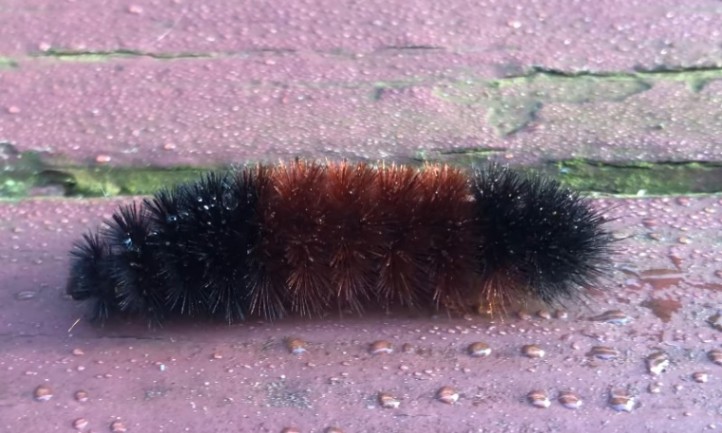
In the far north, the Arctic woolly bear caterpillar (Gynaephora groenlandica) outlasts almost everything. It spends more than seven years in its larval stage, freezing solid every winter and thawing each short summer to feed briefly before refreezing again.
The Slowest Life in the Arctic
Physiological studies show that its metabolism almost stops during frozen periods. Oxygen use, respiration, and circulation all drop to trace levels. When warmed by sunlight, the tissues thaw, the caterpillar stirs, and life resumes within hours.
Over many freeze–thaw cycles, it stores enough energy to finally pupate and become a moth, a record among cold-blooded animals.
Its survival depends on cryoprotectants such as glycerol and on precise control of ice formation. It is one of the clearest examples of true freeze tolerance evolved for the harshest climate on Earth.
Goldenrod Gall Fly
Inside dry, papery galls on goldenrod stems, larvae of Eurosta solidaginis spend winter motionless and frozen. They have become a textbook model for freeze tolerance research.
Inside the Gall
As temperatures fall, larvae build up glycerol, sorbitol, and trehalose , small molecules that prevent internal ice from forming and stabilize proteins. They can tolerate freezing several degrees below zero for weeks at a time.
When the late-winter sun warms the gall, ice inside their bodies melts, metabolic reactions restart, and the larvae slowly resume activity.
Repeated freezing, however, comes at a cost. Experiments show that multiple freeze–thaw cycles increase oxidative stress and mortality, hinting at the physiological price of this remarkable trick.
Upis Ceramboides
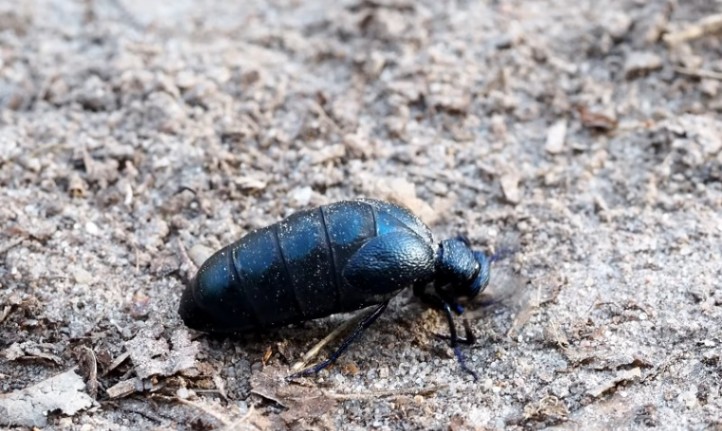
Among all known insects, the Alaskan beetle Upis ceramboides pushes the limits of cold survival. Adults can withstand freezing to almost −60 °C in midwinter.
The Nonprotein Antifreeze
What makes Upis unique is its use of a xylomannan glycolipid , a sugar–lipid molecule that acts like an antifreeze but isn’t a protein. It prevents ice from spreading and modifies crystal shape. Studies from Alaska and Notre Dame confirmed that this molecule can induce “thermal hysteresis,” meaning it changes the temperature at which ice grows and melts.
When spring returns and the bark warms, frozen beetles thaw and begin to walk and feed again, perfectly intact.
Belgica Antarctica
The Antarctic midge (Belgica antarctica) is the southernmost insect on the planet. Its larvae remain active in frozen soil and moss through most of the year.
Life in the Coldest Desert
They combine freeze tolerance with cryoprotective dehydration , a process where water slowly leaves the body and freezes outside, avoiding internal damage.
They also show “rapid cold-hardening,” adjusting their biochemistry within hours of a cold shock.
Remarkably, some of their developmental processes continue even while frozen. Researchers found that DNA repair and certain gene expressions still proceed during frozen periods, proving that cold survival is deeply embedded in their biology.
Cucujus Clavipes
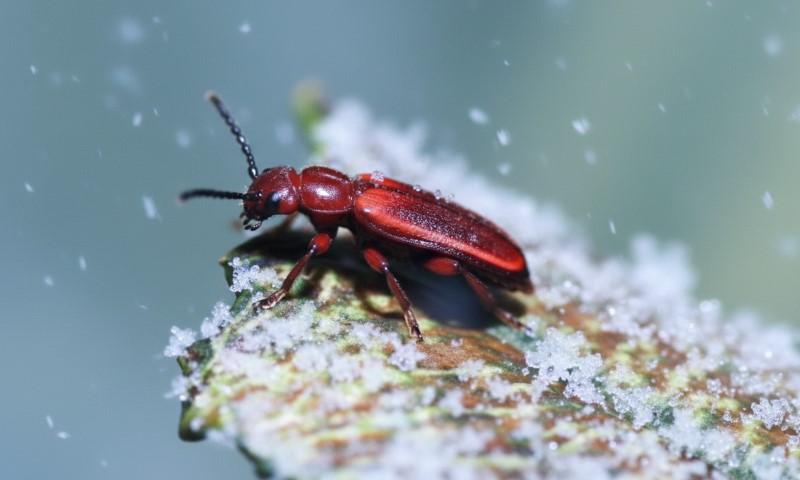
Under the bark of Alaskan trees lies the Cucujus clavipes larva, a champion of supercooling . Its body fluids can drop to −42 °C without freezing. In some conditions, the water inside becomes a vitrified glass-like state , solid but not crystalline.
Biochemically, this relies on antifreeze proteins, dehydration, and the absence of any ice-nucleating material in the gut or tissues.
What “Reawakening in the Sun” Actually Means
Not every cold-induced shutdown involves freezing. Scientists distinguish between two reversible cold states.
Chill Coma
Many insects, like fruit flies or crickets, slip into a chill coma when temperatures drop below a critical limit. They’re not frozen, just paralyzed by an ion imbalance across nerve and muscle membranes. When warmed by sunlight, they recover as ion gradients reset.
Researchers measure “chill-coma recovery time” as a way to assess an insect’s cold tolerance. For example, fruit flies knocked out in a refrigerator can flip upright within minutes under a lamp.
Post-Freeze Revival
In truly freeze-tolerant species, extracellular ice forms overnight. As the sun warms them, the ice melts, and metabolism revives. This is common in Eurosta , Upis , and Belgica .
Survival depends on how cold it got and how long the freeze lasted. Repeated cycles increase oxidative stress, showing that even “ice survivors” have limits.
So, when you see movement on a bright winter day, it might be either type, a thawing freeze-tolerant insect waking from solid ice, or a freeze-avoiding one simply regaining mobility in sunlight.
The Molecular Toolkit Behind Survival
@entomosfunfacts Overwintering buggos in our houses! #funfactwithanentomologist #bugtok #coldhardy #freezing #overwinter #webtoon #scicomm #sneaky #boxelder #hemiptera
Cold-hardy insects rely on a small but powerful set of biochemical tools.
1. Antifreeze Proteins and Glycolipids
- Springtail antifreeze proteins are small, glycine-rich chains that bind to ice and stop its growth.
- Xylomannan glycolipid in Upis ceramboides works without proteins, showing that lipids can also block ice formation.
Both molecules create thermal hysteresis , meaning they shift freezing and melting points independently, a rare feat in biology.
2. Small-Molecule Cryoprotectants
Substances like glycerol, sorbitol, and trehalose lower freezing points and stabilize membranes.
Their concentrations rise in autumn and peak by midwinter, coinciding with maximum tolerance.
3. Water Control and Vitrification
Freeze-avoiding insects purge their guts of food particles and water, eliminating ice-nucleating sites. Some achieve partial vitrification , turning liquid water into a glass-like solid.
Others, like Belgica , rely on cryoprotective dehydration , letting water freeze outside the body while retaining flexible, unfrozen interiors.
4. Cellular Protection and Repair
Heat-shock proteins and antioxidant enzymes prevent structural collapse during freezing and thawing.
But repeated cycles still cause oxidative damage, especially in Eurosta , showing there’s always a physiological cost.
Species and Their Winter Habits
| Species | Strategy | Cold Limit | Winter Habitat | Reawakening Behavior |
| Hypogastrura harveyi (snow flea) | Freeze avoidance | Active below 0 °C | On snow surface near trees | Moves on sunny snow using antifreeze proteins |
| Gynaephora groenlandica (Arctic woolly bear) | Freeze tolerance | Multi-year freezing | Arctic tundra | Thaws and feeds briefly each summer |
| Eurosta solidaginis (goldenrod gall fly) | Freeze tolerance | Freezes to −10 °C | Inside goldenrod galls | Thaws when sun warms the gall |
| Upis ceramboides | Freeze tolerance | To about −60 °C | Under Alaskan bark | Wakes as microhabitats warm |
| Belgica antarctica | Freeze tolerance + dehydration | Year-round | Antarctic soil and moss | Active during short warm windows |
| Cucujus clavipes | Deep supercooling | −35 °C to −42 °C | Under bark | Wakes when bark warms above ice point |
When Eggs Do the Freezing Instead
Even if adult insects can’t survive deep cold, their eggs often can. A striking example is the Asian tiger mosquito (Aedes albopictus).
In temperate regions, its females lay diapause eggs , dormant and fortified with cryoprotectants. Laboratory tests show that these eggs can survive −10 °C for up to a day and −12 °C for shorter periods. Once warmed by sunlight or spring rain, development resumes, and the larvae hatch.
The tropical Aedes aegypti can do something similar, though for shorter freezes. Such resilience helps invasive mosquitoes expand into cooler climates, creating real public health implications.
How to Tell if an Insect Just “Woke Up”
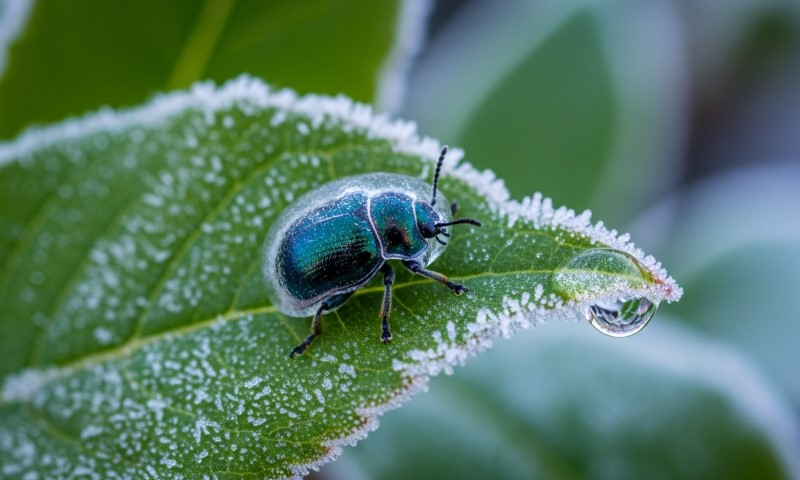
- Surface activity on snow: Springtails often cluster in dark patches near tree bases, hopping across sunlit snow when surface temperatures rise slightly.
- Warm bark or galls: Freeze-tolerant larvae thaw within sheltered spaces once sunlight heats the surrounding wood. A goldenrod gall on a sunny slope can host living larvae even when air temperatures remain below zero.
- Fast recovery from chill coma: Small flies or beetles may lie motionless on cold windowsills but recover within minutes under a heat source or sunbeam, a miniature version of what happens outdoors each winter morning.
Limits and Costs
Even for the toughest species, cold survival isn’t limitless.
- Temperature vs. time: the deeper or longer the freeze, the harder recovery becomes. Eurosta tolerates modest freezes, but survival drops after multiple cycles.
- Seasonal tuning: most insects develop maximum tolerance only after gradual exposure in autumn. Upis beetles, for instance, are not freeze tolerant in summer.
- Species specificity: deep supercoolers like Cucujus die instantly if internal ice forms, while freeze-tolerant insects fail if winter thaws too often.
Key Mechanisms Summarized
| Function | Mechanism | Example |
| Ice control | Ice-binding proteins and glycolipids prevent ice crystal growth | Hypogastrura harveyi , Upis ceramboides |
| Cryoprotection | Glycerol, sorbitol, trehalose stabilize membranes and proteins | Eurosta solidaginis |
| Water regulation | Dehydration and vitrification reduce internal freezing risk | Belgica antarctica , Cucujus clavipes |
| Rapid cold-hardening | Temporary boost in tolerance after short exposure | Belgica antarctica |
| Repair and defense | Antioxidants and chaperones fix freeze–thaw damage | Eurosta solidaginis |
Summary
If you want to know which insects can literally freeze overnight and come back to life under sunlight, start with the proven masters:
- Goldenrod gall fly (Eurosta solidaginis)
- Alaskan beetle (Upis ceramboides)
- Antarctic midge (Belgica antarctica)
They can form ice inside their bodies and still recover once warmth returns.
If you’re looking for creatures active right on the snow surface, springtails and other supercoolers take the spotlight. Beneath bark, Cucujus larvae rest in glassy suspension until a beam of sunlight restarts their chemistry. And at the microscopic level, mosquito eggs quietly bridge winter’s gap, hatching when the season breaks.
Across all of them runs one principle: reawakening in the sun is not magic . It’s the outcome of precise molecular engineering. Ice-binding proteins, antifreeze lipids, sugars, and membrane control work together to make sure that even in the dead of winter, a few insects remain alive, waiting for light.
Related Posts:
- How Fast Can a Camel Run? Which One is Faster?
- 7 Best Pet Lizards That Are Known for Being Friendly…
- Raptor Birds: How They Hunt, Live, and Survive
- Ten Bizarre Insects That Rule the African Desert
- What Do Spider Eggs Look Like and Where Can You Find Them?
- Can Tarantulas Be Good Pets? Pros and Cons of Ownership

